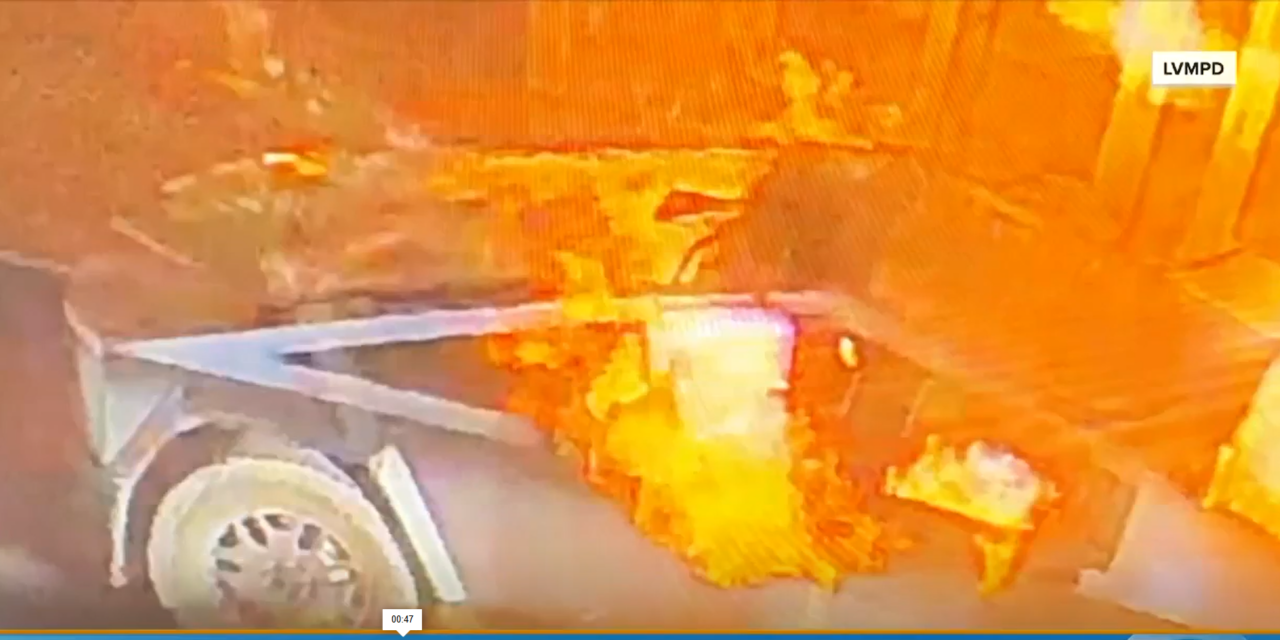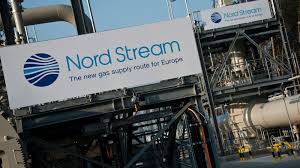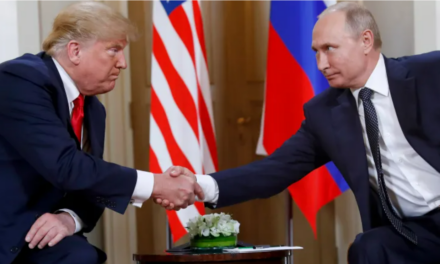The explosion of a Tesla Cybertruck outside Trump Tower in Las Vegas on New Year’s Day 2025 sent shockwaves across the nation, not only for the destruction it caused but for the baffling inconsistencies in the official narrative.
Trump Tower, an iconic symbol of Donald Trump’s influence, has been the site of heightened tensions in recent years, especially as the former president mounts a political resurgence. Simultaneously, Elon Musk, the visionary CEO of Tesla and SpaceX, has emerged as one of Trump’s most vocal allies, openly supporting his vision for reducing bureaucracy and increasing efficiency in government.
Both men are polarizing figures who have drawn ire from entrenched power structures within the U.S. Known for their disruptive influence—Trump in politics and Musk in technology and economics—the pair represent a direct challenge to the so-called “Deep State,” a term used to describe a shadowy network of unelected officials and bureaucrats believed to wield significant influence behind the scenes.
This context frames the backdrop against which the Cybertruck explosion occurred. Livelsberger, a former Green Beret identified as the vehicle’s driver, is claimed by authorities to have taken his own life by gunshot before the explosion. Despite this, the incident raises troubling questions about the plausibility of the official account, the motive behind the attack, and whether it was a personal act of despair or a meticulously orchestrated warning.
The Cybertruck itself, an emblem of Musk’s innovative spirit, absorbed much of the explosion’s force, minimizing the physical damage to the surroundings but amplifying the symbolic weight of the attack. With Trump having survived two prior assassination attempts and Musk’s increasing involvement in reshaping federal operations, the timing and execution of the explosion hint at something far more calculated than a lone actor’s desperation. Could this incident be a message—a show of force by those who feel threatened by the disruptive power of Trump and Musk?
Authorities claim to have identified the driver as Livelsberger, a decorated Green Beret, using a plastic coated paper Army ID and a US Passport both found in the burnt out Cybertruck. This claim stretches plausibility: how could 2 paper and plastic documents survive an inferno that rendered the body “burned beyond recognition”? This is eerily reminiscent of 9/11, where a hijacker’s passport was supposedly found intact amidst the fiery collapse of the Twin Towers—an anomaly that has long fuelled conspiracy theories.
Investigators state that Livelsberger died of a self-inflicted gunshot wound before the explosion. If true, how did a deceased man drive the Cybertruck into position, park it, and ignite an explosion?
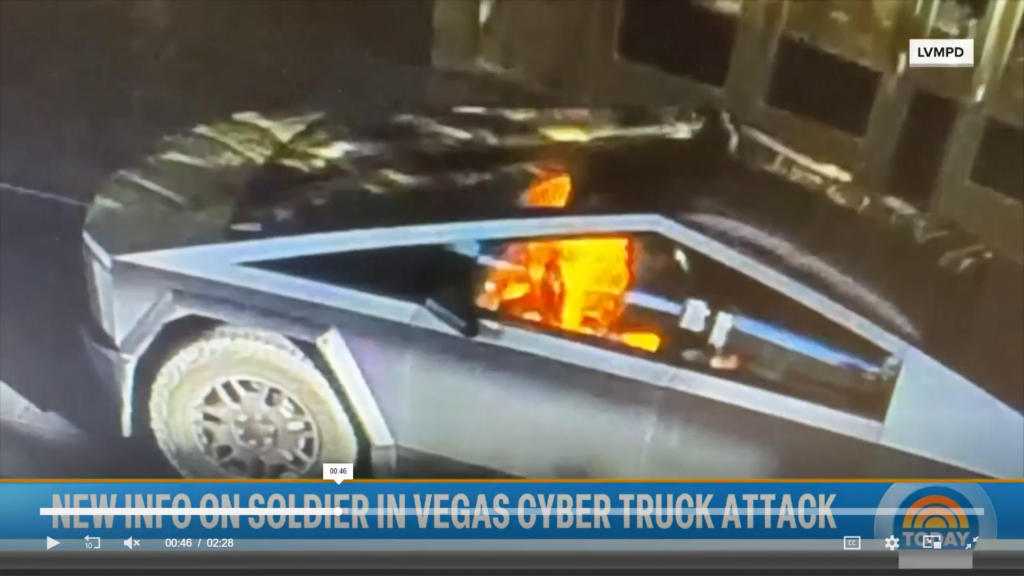
CCTV footage shows the driver sitting upright at the moment of ignition. This contradicts the claim that Livelsberger had shot himself in the head, which would have left his body slumped forward, backward or to the side.
The explosion’s ignition point was in the passenger seat, not in the truck bed with the fireworks and petrol cans. Strangely, the petrol cans survived intact, despite the truck cabin being completely destroyed.
Livelsberger, as a highly trained Green Beret, would have known that the Cybertruck’s robust design would absorb much of an explosion’s force. Why would a seasoned operative choose a vehicle that would mitigate the intended impact?
Trump and Musk are no strangers to controversy. Trump, the twice-impeached president and now president-elect, has survived two prior assassination attempts. Musk, a vocal supporter, is reportedly being considered for a role in dismantling entrenched bureaucracy within the federal government. Together, they pose a significant challenge to the so-called Deep State—a shadowy, unelected network allegedly wielding power behind the scenes.
Could the explosion have been a warning? The Deep State may have orchestrated the event to demonstrate its reach, reminding both men that no one is untouchable. The use of Livelsberger, a Green Beret, would add another layer of psychological warfare, showcasing the ability to compromise even the most elite individuals.
Addressing the Questions with a Deep State Lens
The official narrative claims that the Cybertruck’s driver, identified as 38-year-old Green Beret Livelsberger, took his own life with a gunshot before the explosion occurred. However, numerous inconsistencies raise doubts about this account, leading to the question: Was the driver already dead before the vehicle reached Trump Tower?
The scenario that Livelsberger’s body was placed in the truck post-mortem presents a chilling alternative hypothesis. If Livelsberger was not the perpetrator but rather a victim, his role may have been orchestrated to create a false narrative and deflect attention from the true culprits. The body found in the vehicle was reportedly burned beyond recognition, a fact that conveniently prevents independent verification of the driver’s identity. Authorities claim to have identified him using his Army ID and his US Passport, keep in mind that the Army ID was a paper document coated in plastic and his passport is made of paper, both of these flimsy documents were allegedly found intact in a fire intense enough to incinerate human remains—a glaring contradiction.
An even more unsettling possibility is that the body found in the truck was not Livelsberger at all but someone carefully selected to resemble him. This hypothesis would explain several puzzling details:
The use of a paper passport and a plastic Army ID as the primary means of identification is dubious at best. In cases of severe fire damage, forensic investigators typically rely on dental records, DNA, or other more reliable methods. The quick declaration of Livelsberger’s identity based on such flimsy evidence raises suspicions of a planted narrative.
If the body was placed in the vehicle after death, it would indicate a highly coordinated effort to stage the scene. This would also align with reports that CCTV footage showed the driver’s silhouette sitting upright at the moment of ignition, which is inconsistent with someone who had reportedly died from a gunshot wound.
Selecting someone who bore a resemblance to Livelsberger or whose remains could be passed off as his would serve several purposes:
Creating a Patsy: Pinning the attack on a lone, troubled individual diverts attention from any larger conspiracy.
Protecting the True Perpetrators: By focusing the investigation on Livelsberger, the real architects of the operation avoid scrutiny.
Ensuring Plausibility: The use of a Green Beret with a high-security background adds credibility to the idea that this was a lone-wolf attack, while his death conveniently silences any chance of questioning his motives.
Livelsberger, as a former Green Beret, represents an ideal scapegoat. His military background provides a narrative of someone capable of carrying out such a calculated act. Yet there is no clear evidence linking him to the motivations authorities have suggested. If Livelsberger was not complicit, it is possible that his identity was appropriated posthumously to fit the narrative.
If the driver was dead before the Cybertruck reached Trump Tower—and if the body was not Livelsberger’s—the incident takes on a far more sinister tone. It suggests a level of coordination, resources, and operational sophistication far beyond what a lone actor could achieve. This points toward a deliberate operation designed to send a specific message, not just to the public but to key figures like Trump and Musk.
If the true intention was to warn Trump and Musk, staging the scene with such precision could serve as a statement:
“We can manipulate evidence, create narratives, and operate beyond detection.”
The choice of a recognizable figure like Livelsberger—whether or not the body was his—adds to the plausibility of the official story while concealing the true motives and perpetrators behind the event.
The possibility that the body found in the Cybertruck was not Livelsberger but someone chosen to resemble him opens the door to a far-reaching conspiracy. If true, it suggests the attack was not merely a random act but a calculated operation involving deception, manipulation, and a deliberate attempt to create a false narrative. In this light, the explosion at Trump Tower may well have been more than an isolated incident—it could have been a carefully orchestrated message with implications far beyond what we currently understand.
Why Was a Robust Cybertruck Used If It Absorbs Explosive Force?
The choice of a Tesla Cybertruck as the vehicle for this attack is one of the most perplexing elements of the incident. The Cybertruck’s unique design, featuring ultra-hard 30X cold-rolled stainless steel and Tesla Armor Glass, makes it one of the most robust consumer vehicles on the market. This structural integrity is not just a selling point for its commercial appeal but also a significant factor in limiting the destructive impact of an explosion. Given this, why would a seasoned operative—or those orchestrating such an event—choose a vehicle inherently designed to minimize explosive damage?
Video from CCTV in Las Vagas, NV Courteous of CNN
The use of the Cybertruck could carry a deeper, symbolic message aimed squarely at Elon Musk. Musk has become a prominent figure in politics and culture, not just for his technological innovations but for his outspoken support of Donald Trump and his critique of entrenched bureaucratic power.
The Cybertruck is one of Tesla’s most iconic and polarizing vehicles, symbolizing Musk’s innovation and defiance of traditional automotive norms. By using this vehicle in an attack outside Trump Tower, the perpetrators could be sending a message to Musk, associating his brand and influence with chaos, destruction, and danger.
The incident could be designed to taint Musk’s public image, portraying his innovations as tools of destruction rather than progress. It aligns with a broader campaign to discredit Musk, who has increasingly been at odds with powerful political and media institutions due to his control of platforms like X (formerly Twitter) and his vocal support of Trump’s agenda.
Using the Cybertruck—a product of Musk’s vision—might also serve as a broader warning to disruptors who challenge the status quo. It communicates that even the symbols of their success can be turned against them.
The presence of the Cybertruck outside Trump Tower creates a layered association between two high-profile disruptors: Trump and Musk. Trump Tower is synonymous with Trump’s legacy and political power, while the Cybertruck represents Musk’s technological dominance. Targeting both in one incident creates a powerful symbolic act, suggesting that the perpetrators were capable of reaching not just physical locations but also the reputations and legacies of these figures.
The Deep State, as alleged by critics, operates with precision, subtlety, and an eye for symbolism. If this attack was orchestrated by such a network, the use of the Cybertruck serves multiple purposes:
Choosing Musk’s most durable vehicle for a destructive act demonstrates control and ingenuity, sending a message to Musk that his innovations can be weaponized against him.
By targeting both Musk and Trump in a single symbolic attack, the perpetrators showcase their ability to affect the lives and narratives of two of the world’s most influential disruptors.
The use of the Cybertruck in such an act might also be intended to create paranoia and distrust within Musk’s circle, making him question the loyalty of those who have access to his technology.
The message is clear:
“Even the most secure, durable innovations cannot protect you from us.”
By using the Cybertruck as both a physical and symbolic tool, the Deep State could be flexing its ability to control the narrative and instil fear in its targets.
The choice of the Cybertruck as the centrepiece of this attack defies logic if the goal were maximum destruction. Instead, it appears to be a calculated move with symbolic undertones aimed at Musk, Trump, and their shared vision of dismantling entrenched power structures. If this was a Deep State operation, the Cybertruck was not just a vehicle—it was a statement, a psychological weapon used to send an unmistakable warning to those challenging the status quo.
How Could the Cybertruck Be Driven Around with Only a Dead Body in It?
If the presumption is that the driver was already deceased before the Cybertruck was parked outside Trump Tower, this raises serious questions about how the vehicle was maneuverer to the scene. The idea that a lifeless body could operate the vehicle defies logic, suggesting the use of advanced technology or outside intervention.
Possible Explanations and Hypotheses
Cybertrucks are equipped with advanced features, including autonomous driving capabilities. A modified version of Tesla’s Autopilot or a remote control system could have been used to manoeuvre the vehicle without requiring a living driver.
- Remote Operation:
If the truck’s systems were hacked or preprogrammed, the vehicle could have been driven remotely to the location. Tesla vehicles are already capable of limited remote functions via apps, making this scenario technically feasible with additional modifications. - Autonomous Driving Preprograming:
The truck could have been programmed to follow a specific route and stop outside Trump Tower, mimicking human operation to avoid suspicion.
Sophisticated Staging by a Third Party
If the incident was orchestrated by a well-resourced entity like the Deep State, the truck could have been modified to give the illusion of a human operator. This could include using mannequins, dummies, or advanced robotics to simulate a driver’s presence on CCTV footage.
Manipulation of CCTV Footage
The silhouette of a person seen in CCTV footage at the point of ignition adds to the mystery. If the driver was already deceased, their head would not remain upright. This raises the possibility that the footage was doctored to reinforce the official narrative.
- Deepfake Technology:
Modern video editing tools could create a convincing illusion of a driver sitting upright at the moment of the explosion. - Selective Frame Cropping:
The footage could have been selectively edited to obscure inconsistencies, such as the driver’s actual posture.
If this was a staged operation, ensuring the Cybertruck reached its destination without a living driver demonstrates the level of sophistication behind the event. The ability to remotely control a vehicle or manipulate evidence serves as a chilling reminder of the technological capabilities at play.
The use of a highly advanced and symbolic vehicle like the Cybertruck reinforces the idea that even cutting-edge technology can be co-opted and weaponized. This sends a message to Musk and Trump, who have positioned themselves as disruptors of entrenched systems.
By ensuring the truck appeared to have been driven by a single individual, the perpetrators eliminated variables that could complicate the narrative.
The question of how a Cybertruck could be driven with only a dead body inside points to external intervention, whether through remote control technology, preprograming, or third-party staging. This detail, like others in the incident, highlights the meticulous planning and technological expertise behind the event, supporting the hypothesis of a calculated operation designed to intimidate and manipulate.
How Was the Ignition Point in the Cabin Started While Leaving Petrol Cans intact?
One of the most perplexing aspects of the Cybertruck explosion is the location and nature of the ignition point. According to investigators, the ignition occurred inside the cabin of the vehicle rather than in the rear compartment, where a stockpile of fireworks and petrol cans was located. This anomaly raises critical questions about how the explosion was initiated, its purpose, and the intended outcome.
The unusual placement of the ignition point suggests a deliberate, controlled detonation rather than an improvised or accidental explosion. The fire and resulting destruction were concentrated in the truck’s cabin, while the petrol cans in the back remained largely intact. This precision is indicative of a planned event with the following potential objectives.
By containing the explosion within the cabin, specific elements—such as the truck’s frame, evidence of fireworks, and petrol cans—were left intact, providing investigators with exactly what they needed to construct a plausible narrative. The petrol cans’ survival is particularly suspicious, as even minimal heat exposure should have caused them to ignite or explode.
The intense fire in the cabin ensured the driver’s body was burned beyond recognition, effectively preventing independent verification of the body’s identity. If the body was planted or substituted, this tactic would prevent any forensic evidence from contradicting the official story.
Containing the explosion to the cabin limited the physical damage to the surrounding area, creating a controlled spectacle rather than an indiscriminate act of violence. This aligns with the hypothesis that the event was more about sending a symbolic message than causing mass casualties.
Possible Methods of Detonation
A remotely triggered ignition device could have been placed in the cabin to ensure precise timing and location of the blast. This would allow the perpetrators to detonate the device once the truck was parked outside Trump Tower, ensuring maximum symbolic impact.
The ignition point being in the passenger seat suggests that a pre-planted device may have been used. Such a device could be designed to trigger upon impact, motion, or after a specific time delay.
A chemical reaction-based ignition system could have been employed, ensuring the explosion occurred at a precise time. This method could also be designed to produce an intense fire.
.
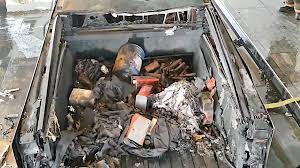
The survival of the petrol cans is one of the most puzzling aspects of the incident. Under normal circumstances, these cans should have exploded due to the fire. Their intact state suggests careful planning
The use of a controlled ignition device in the cabin may have ensured that the fire burned intensely in a confined area while spreading to the rear compartment where the petrol cans were stored. This precision indicates a staging of items to distract from the real ignition point in the cabin.
Preserving the petrol cans and carefully placed fireworks points to an intentional effort to avoid creating a larger explosion. This suggests the event was designed to be a controlled demonstration of power rather than an act of indiscriminate destruction.
Allowing the petrol cans to remain intact so media could report on them further cements the narrative being pushed.
If this explosion was orchestrated by the Deep State or a similarly powerful network, the controlled ignition in the cabin serves several purposes.
The cabin fire destroyed the driver’s body and any forensic evidence that might contradict the official story, while the intact petrol cans lent credibility to the idea of a lone actor staging a chaotic attack.
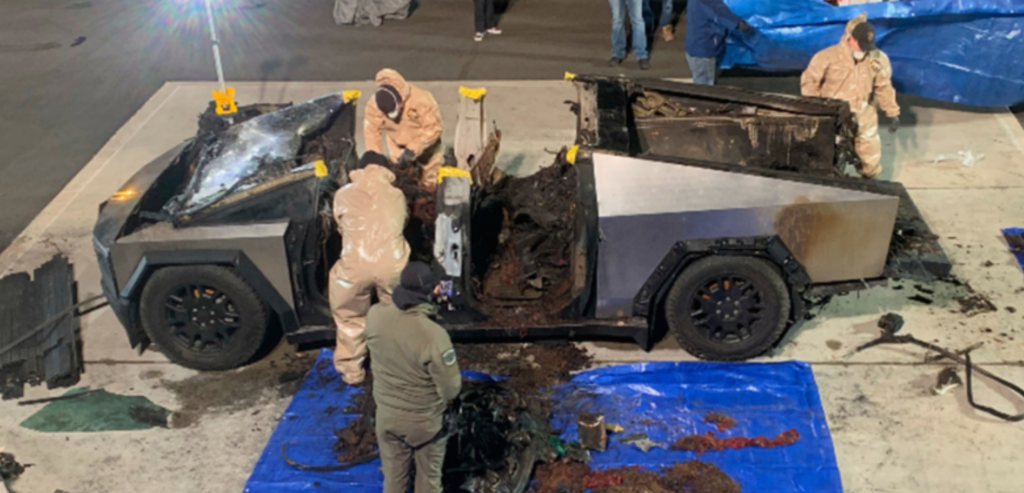
The precision of the detonation reflects a level of expertise that would be beyond the capabilities of a distraught individual acting alone. This serves to intimidate targets like Trump and Musk by showcasing the operational prowess of those behind the event.
The choice of the Cybertruck, coupled with the location of the ignition, creates a layered message. To Musk, it signals that even his innovations can be manipulated and weaponized. To Trump, it reinforces that threats can be delivered in ways that are both symbolic and controlled.
By ensuring specific elements of the scene remain intact, the perpetrators guide investigators toward a predetermined conclusion, shielding themselves from suspicion and scrutiny.
Unanswered Questions
- How was the ignition device triggered with such precision, and why was it not detected during the investigation?
- Why were materials like petrol cans which their contents are highly combustible, left completely intact?
- Who had the expertise to execute such a controlled detonation, and what resources were used to plan and carry it out?
The ignition point in the cabin and the intact state of the petrol cans point to a controlled, calculated event rather than a spontaneous act. This level of precision strongly suggests the involvement of an entity with significant resources and expertise, aligning with the hypothesis of a Deep State operation. The goal may have been to stage an incident that appears plausible on the surface while sending a sophisticated and chilling message to Musk, Trump, and their allies:
“We have the power to operate in plain sight, control the narrative, and leave no trace.”
How Did the Plastic and Paper IDs Survive When the Body Was Destroyed?
One of the most perplexing aspects of the Cybertruck explosion is the survival of both a plastic-coated Army ID and a paper U.S. passport, allegedly belonging to Green Beret veteran Livelsberger. These items were reportedly found amidst the ashes of a fire so intense it left the body burned beyond recognition and destroyed the truck’s interior. The improbability of such fragile materials surviving under these conditions raises significant questions about their authenticity and the broader narrative surrounding the incident.
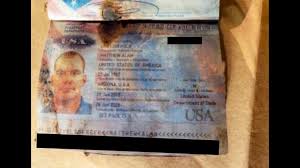
Fires fuelled by accelerants, such as gasoline and fireworks, generate extreme heat capable of obliterating organic and synthetic materials alike. In this case:
Authorities reported that the fire was so severe it rendered the body “burned beyond recognition,” implying temperatures far exceeding what paper or thin plastic could withstand.
It is scientifically implausible for fragile materials like paper to remain intact while organic tissue and other materials are completely destroyed.
The IDs were not reported to have been encased in fireproof containers or shielded by any means that could explain their survival.
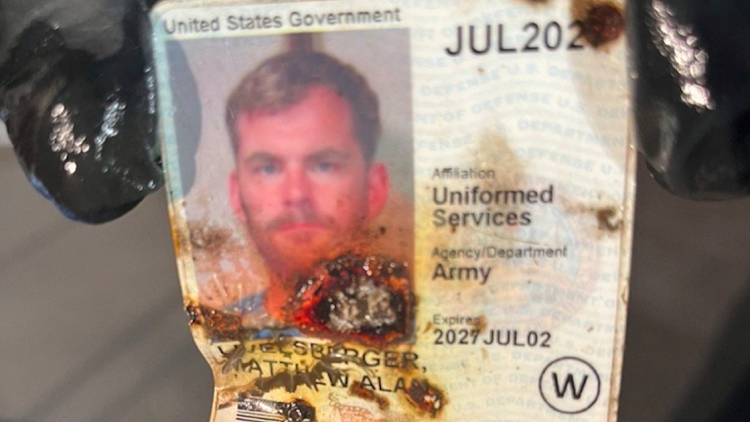
This detail starkly contrasts with the destruction of other materials within the vehicle, such as clothing, upholstery, and personal effects.
The Staged Evidence Hypothesis
The survival of the IDs points to deliberate placement, a hallmark of staged operations designed to direct the narrative. Several elements support this hypothesis:
The IDs provide an immediate and convenient resolution to the question of identity, preempting the need for a prolonged forensic investigation.
Without such evidence, determining the body’s identity through DNA or dental records could take weeks, opening the door for closer scrutiny of the event’s inconsistencies.
The discovery of these IDs is reminiscent of the controversial finding of a hijacker’s passport at Ground Zero, which critics argue defied logic given the catastrophic destruction of the Twin Towers.
Both cases suggest the deliberate planting of evidence to establish a narrative that would otherwise lack credibility.
If the body was not Livelsberger’s, planting his IDs would serve to shift blame onto someone already deceased or incapable of contesting the accusations.
This possibility aligns with the broader hypothesis of a carefully orchestrated operation by powerful entities seeking to control public perception.
Questions That Demand Answers
- How could fragile paper and plastic IDs survive when the body and interior of the vehicle were obliterated?
- Was the ID placed deliberately to steer investigators toward Livelsberger?
The survival of Livelsberger’s IDs amidst the destruction of the Cybertruck incident challenges the laws of physics and logic, pointing to deliberate orchestration, establishing a clear but highly questionable narrative while avoiding deeper scrutiny of the incident. This anomaly, alongside other inconsistencies, reinforces the hypothesis that the event was a meticulously planned operation, potentially involving powerful networks intent on sending a chilling message and maintaining control over public discourse.
Final Thoughts
This article does not seek to answer what happened but to look at the narrative that has been pushed by authorities and point out the inconsistencies, it seeks to question these inconsistencies and pose probable alternate hypotheses that fit the evidence as it stands.
The Cybertruck explosion at Trump Tower is steeped in anomalies that challenge the official narrative. From the unscathed paper IDs found amid a fire so intense it rendered the body unrecognizable, to the improbable survival of petrol cans in a controlled yet symbolic blast, every detail raises more questions than answers. The precision of the explosion, the intact state of key materials, and the symbolic use of Elon Musk’s signature vehicle all point to a level of planning and expertise far beyond that of a distraught individual acting alone.
When viewed alongside historical precedents like the 9/11 passport controversy and the growing role of public figures like Trump and Musk in challenging entrenched power structures, the incident begins to take on the characteristics of a meticulously staged operation. Whether it was a chilling message from the Deep State, a false flag designed to misdirect and intimidate, or an as-yet-unknown conspiracy, the layers of improbability and unanswered questions demand deeper investigation.
Ultimately, the Cybertruck explosion serves as a stark reminder of the complex web of influence, power, and perception that defines modern geopolitical struggles. In an era where narratives are shaped as much by omission as by evidence, the unanswered questions surrounding this event should remain at the forefront of public scrutiny. To dismiss them as coincidence or conspiracy is to ignore the possibility of a calculated effort to manipulate reality itself.

